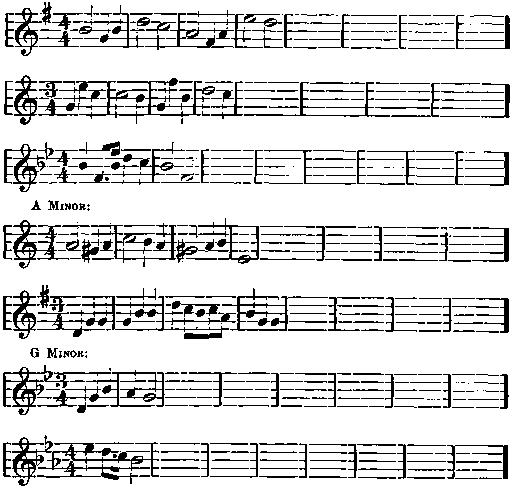Harmony Book For Beginners - online book
Scales, Intervals, Common Chords, Dominant Seventh Chord and Melody Making.
| Share page | Visit Us On FB |
|
< |
|||
|
ON MELODY MAKING |
143 |
||
|
Let us analyze this. Measure 1, the Principal Motive contains the Root and Third of the Tonic Chord (F, A, C). Measure 2, the Second Motive contains the Fifth (G) and the Root (C) of the Dominant Chord. Measures 3 and 4, the Second Section, are in Rhyme with Measures 1 and 2. Measure 5 starts the Second Phrase with a return to the Principle Motive. Measure 6 suggests the Subdominant Chord ( Bb, D, F ). Measure 7 contains the Third of the Tonic Chord (A), and the Seventh ( Bb ) and the Fifth (G) of the Dominant Seventh Chord. Measure 8 brings us to a close on the Tonic.
Now, let the student try some Melodies, using Diatonic Motives, occasional skips, or Motives derived from Chords. The opening Phrases, Sections or Motives are given.
Begin on some Member of the Tonic Chord, and end on the Tonic Degree. |
|||
|
|
|||
 |
|||
|
|
|||
|
The foregoing exercises will have served to give the student some insight into the mechanical process of melody making. It is. in reality melody building. One hears much of inspiration, and doubtless many fine melodies have come through inspiration; but only after logical habits of thought have been acquired through earnest study and practice. A whole book might be written on melody making but in this Chapter we have contented ourselves with starting the student on his way. To recapitulate: follow the three artistic Principles; use only one or two Motives in any one Melody and work them out logically; let each leading Motive, Section and Phrase appear to ask a question, which the following Motive, Section, and Phrase, respectively, answers, the Period being the completed musical sentence.
Now let the student make some Periods, inventing his own Motives. We will indicate only the Scale, and the Time Signature of each one. |
|||